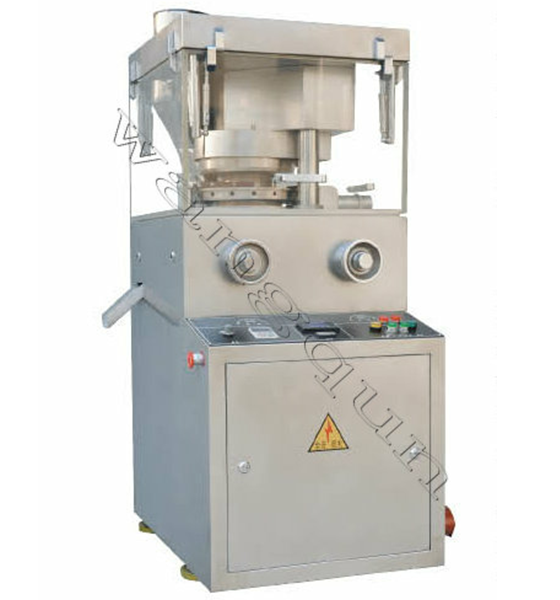How to Operate a rotary tablet press Safely and Efficiently: A Complete Guide
Operating a rotary tablet press safely and efficiently is critical for high-quality pharmaceutical and nutraceutical production. This machine compresses powders and granules into tablets with uniform weight, size, and hardness, and proper handling ensures consistent output, energy efficiency, and operator safety. This guide covers model specifications, safety precautions, energy-saving benefits, and solutions for common challenges, helping manufacturers maximize production performance.
Table of Contents
Overview of Rotary Tablet Press
Specifications and Models
Safety Precautions and Operational Guidelines
Energy Efficiency and Cost-Saving Benefits
Troubleshooting and Solutions
Maintenance and Cleaning Procedures
Applications in Pharmaceutical Manufacturing
Conclusion
1. Overview of Rotary Tablet Press
A rotary tablet press is a high-capacity machine designed for continuous tablet production. It features a multi-station rotary turret, allowing simultaneous compression at multiple points, which ensures high efficiency and consistency. Widely used in pharmaceuticals, dietary supplements, herbal medicines, and vitamins, the press enables manufacturers to meet large-scale production targets while maintaining GMP and FDA compliance.
Key advantages include:
Consistent tablet size, weight, and hardness
Adjustable compression pressure and fill depth
Digital control system for precise operation
Modular components for easy maintenance and replacement
Built-in safety shields and emergency stop systems

2. Specifications and Models
Rotary tablet presses come in a variety of specifications to accommodate different production needs. The table below summarizes typical models and specifications:
| Model | Turret Stations | Max Compression Force | Tablet Diameter Range | Tablet Thickness | Max Filling Depth | Production Capacity | Motor Power | Weight |
|---|
| ZP30-17 | 17 | 30 kN | 5–20 mm | 2–6 mm | 12 mm | 5,000–15,000 tablets/hr | 3 kW | 950 kg |
| ZP50-11 | 11 | 50 kN | 6–25 mm | 2–8 mm | 15 mm | 10,000–30,000 tablets/hr | 4 kW | 1,200 kg |
| ZP80-10 | 10 | 80 kN | 8–25 mm | 3–8 mm | 15 mm | 15,000–50,000 tablets/hr | 5–7 kW | 2,000 kg |
Note: Specifications may vary depending on manufacturer and production requirements.
3. Safety Precautions and Operational Guidelines
Operating a rotary tablet press safely is essential to prevent accidents, machine damage, and production errors. Key precautions include:
3.1 Preparation Before Operation
Inspect the machine for wear, damage, or misalignment
Ensure all safety shields and emergency stop systems are functional
Clean the hopper, punches, and dies
Confirm that lubrication systems are filled and operational
3.2 Material Handling
Load powders or granules into the hopper evenly
Avoid overfilling, which may cause blockages or uneven compression
Ensure consistent material flow using the feeder system
3.3 Machine Operation
Turn on the machine using the digital control panel
Adjust pressure, turret speed, and fill depth according to tablet specifications
Monitor initial batches to ensure uniform tablet weight, thickness, and hardness
Use the emergency stop in case of abnormal conditions
3.4 Operator Safety
Wear personal protective equipment (PPE), including gloves, goggles, and masks
Never place hands near moving punches or dies
Follow lockout/tagout procedures during maintenance or cleaning
4. Energy Efficiency and Cost-Saving Benefits
Modern rotary tablet presses are designed to be energy-efficient, reducing operational costs without compromising production quality. Key features include:
Optimized motor systems that consume less electricity during high-speed operation
Variable frequency drives (VFDs) for precise speed control
Low-friction turret and roller designs to minimize energy loss
Reduced downtime due to modular and easy-to-maintain components
Energy-efficient operation helps manufacturers save on electricity bills and supports sustainable production practices in pharmaceutical manufacturing.
5. Troubleshooting and Solutions
Common issues in rotary tablet presses can affect tablet quality and machine performance. Practical solutions include:
| Problem | Possible Cause | Solution |
|---|
| Uneven tablet weight | Improper fill depth or powder inconsistency | Adjust filling system, check powder flow |
| Cracked tablets | Excessive compression pressure | Reduce pressure, check punch alignment |
| Tablet sticking | High moisture content or inadequate lubrication | Dry powder, clean and lubricate punches |
| Machine vibration | Loose components or uneven base | Tighten bolts, level machine base |
| Reduced output | Worn punches/dies | Replace punches or dies, check turret alignment |
Regular preventive maintenance can prevent most issues and maintain consistent production quality.
6. Maintenance and Cleaning Procedures
Maintaining a rotary tablet press ensures long-term efficiency and safety:
Clean powder-contact surfaces after each batch
Inspect punches and dies for wear and replace as needed
Lubricate moving parts according to manufacturer guidelines
Check hydraulic and electrical systems for proper function
Document maintenance and repairs for quality control compliance
7. Applications in Pharmaceutical Manufacturing
Rotary tablet presses are widely used in:
Pharmaceuticals: Prescription drugs, painkillers, vitamins
Nutraceuticals: Herbal and dietary supplements
Food Industry: Compressed candy, sweeteners, effervescent tablets
Chemical Industry: Detergent, water treatment, and catalyst tablets
Veterinary Medicine: Animal health tablets with precise dosing
The machine supports high-volume production while maintaining uniform tablet quality, making it ideal for multiple industries.
8. Conclusion
Operating a rotary tablet press safely and efficiently is essential for high-quality, cost-effective, and compliant tablet production. By following safety precautions, proper operation guidelines, energy-saving practices, and regular maintenance, manufacturers can maximize machine performance and minimize downtime. With its advanced design, digital controls, and high output capacity, the rotary tablet press is an essential tool for pharmaceutical, nutraceutical, and supplement manufacturers worldwide.











 Phone
Phone
Comment
(0)